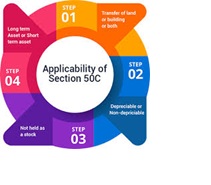
SECTION 50C ADDITION W/O DVO REFERENCE POSSIBLE..?
Amit Sabharwal vs. Asst. Director of Income Tax, CPC, Bengaluru / ITO, Ward 46(3), New Delhi
ITA No. 5292/Del/2024
Order Date: 12 March 2025
Bench: ITAT Delhi
Assessment Year (AY): 2019-20
1. Background and Facts of the Case
• The assessee, Amit Sabharwal, filed his Income Tax Return (ITR) on 25.10.2019, declaring a total income of Rs. 62,43,461/-.
• He disclosed Long-Term Capital Gains (LTCG) of Rs. 46,23,385/- from the sale of an immovable property in Noida, for a sale consideration of Rs. 1,58,43,750/-.
• The stamp duty valuation (circle rate) of the property was Rs. 1,94,95,000/-.
• Both the actual sale consideration and the circle rate were fully disclosed in the ITR.
• During 143(1) processing, CPC proposed an adjustment of Rs. 36,51,250/- (the difference between the circle rate and actual sale consideration), invoking Section 50C(1).
• The assessee objected, but CPC still made the adjustment under Section 143(1)(a)(ii).
2. Legal Issue
Whether an addition under Section 50C(1) can be made as an adjustment under Section 143(1)(a)(ii), during the summary processing of returns?
3. Assessee’s Arguments
• Once the assessee objected to the application of Section 50C(1), the proper procedure under Section 50C(2) required the Assessing Officer (AO) to refer the valuation dispute to the Department Valuation Officer (DVO).
• The failure to make such a reference, and mechanically adjusting the declared sale consideration, violates the statutory safeguards provided under Section 50C.
• The adjustment under Section 143(1)(a) is permissible only in cases of objective errors or incorrect claims apparent from the return; a subjective determination under Section 50C(1) does not qualify.
• Cited Inder Jeet Malik vs. ITO (ITA No. 1024/Del/2022, dated 26.07.2022), where ITAT Delhi held that Section 50C adjustments cannot be made at the 143(1) stage without following due process under Section 50C(2).
4. Revenue’s Position
• CPC proceeded under Section 143(1)(a)(ii) on the ground that the assessee’s declared sale consideration was less than the stamp duty value, and such inconsistency justified the adjustment.
• The sale consideration and circle rate were both disclosed in the return, so the CPC treated it as an incorrect claim apparent from the return.
• The Revenue argued the adjustment was within the permissible scope of 143(1)(a).
5. Tribunal’s Observations
a) Understanding Section 50C
• Section 50C creates a legal fiction (deeming provision):
• Sub-section (1): Substitution of stamp duty value as deemed consideration for capital gains if it exceeds actual sale consideration.
• Sub-section (2): If the assessee objects to the stamp duty valuation, the AO must refer the case to the DVO for valuation.
• Sub-section (3): If the DVO’s value is lower, that becomes the final deemed sale consideration.
b) Summary Nature of Section 143(1)
• Section 143(1) is intended for summary processing, confined to objective issues like:
• Arithmetical errors
• Incorrect claims apparent from return
• Mismatches with Form 26AS, etc.
• The Explanation to Section 143(1)(a) defines “incorrect claim apparent from any information in the return.”
• An adjustment under Section 50C(1) is not purely arithmetical; it requires the assessee’s objection to be addressed via a DVO reference.
• If CPC makes such an adjustment, it denies the assessee the statutory right under Section 50C(2).
• Such complex determinations cannot be the subject matter of 143(1)(a) adjustments.
6. Tribunal’s Ruling
Key Findings:
• Section 50C must be read holistically, not in isolation.
• Sub-section (2) grants the assessee a valuable right to contest the stamp duty valuation.
• CPC cannot make adjustments under Section 143(1)(a) that effectively override Section 50C(2).
• Such adjustments fall outside the scope of 143(1)(a), particularly sub-clause (ii), as they are not incorrect claims apparent from the return.
• CPC’s action circumvented the procedure laid out in 50C(2) and 50C(3).
Decision:
• Relying on Inder Jeet Malik vs. ITO (ITA No. 1024/Del/2022), ITAT Delhi deleted the addition of Rs. 36,51,250/-.
• Held that no addition under Section 50C(1) can be made while processing ITR under Section 143(1)(a).
7. Case Citation Relied Upon
Inder Jeet Malik vs. ITO
• ITA No. 1024/Del/2022
• Order Date: 26.07.2022
• Held: Adjustment under Section 50C(1) at the CPC stage under 143(1)(a) is unsustainable because it deprives the assessee of the opportunity to invoke Section 50C(2) for DVO reference.
8. Legal Principles Established
1. Deeming provisions (like Section 50C) must be applied in entirety, including procedural safeguards.
2. Section 143(1)(a) adjustments are limited to objective inconsistencies; subjective issues requiring enquiry/referral are outside its scope.
3. Assessee’s statutory right to object under Section 50C(2) cannot be curtailed at the summary processing stage by CPC.
4. Adjustment under Section 50C(1) without DVO reference (on objection) amounts to violating principles of natural justice.
9. Practical Implication
• CPC cannot make Section 50C(1) adjustments at the 143(1)(a) stage if the assessee objects to the stamp duty valuation.
• Only regular assessment (Section 143(3)) following DVO reference can address such disputes.
• Taxpayers must promptly object to CPC adjustments invoking Section 50C to preserve their rights under 50C(2).
10. Final Holding of the Tribunal
Addition of Rs. 36,51,250/- under Section 50C(1), made via Section 143(1)(a)(ii) adjustment by CPC, is deleted.
No such adjustment/addition is permissible while processing returns under Section 143(1) without due compliance with Section 50C(2).
